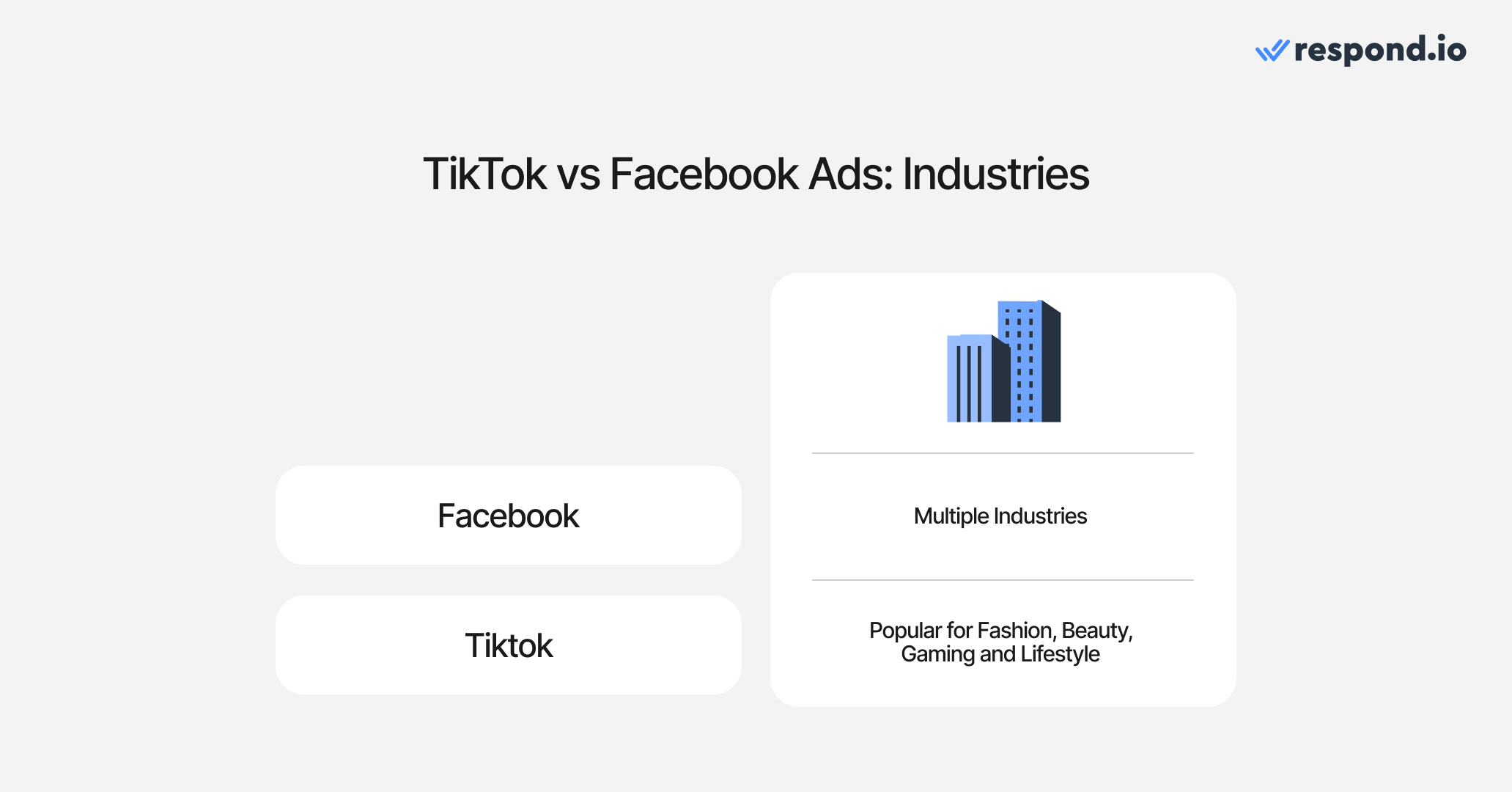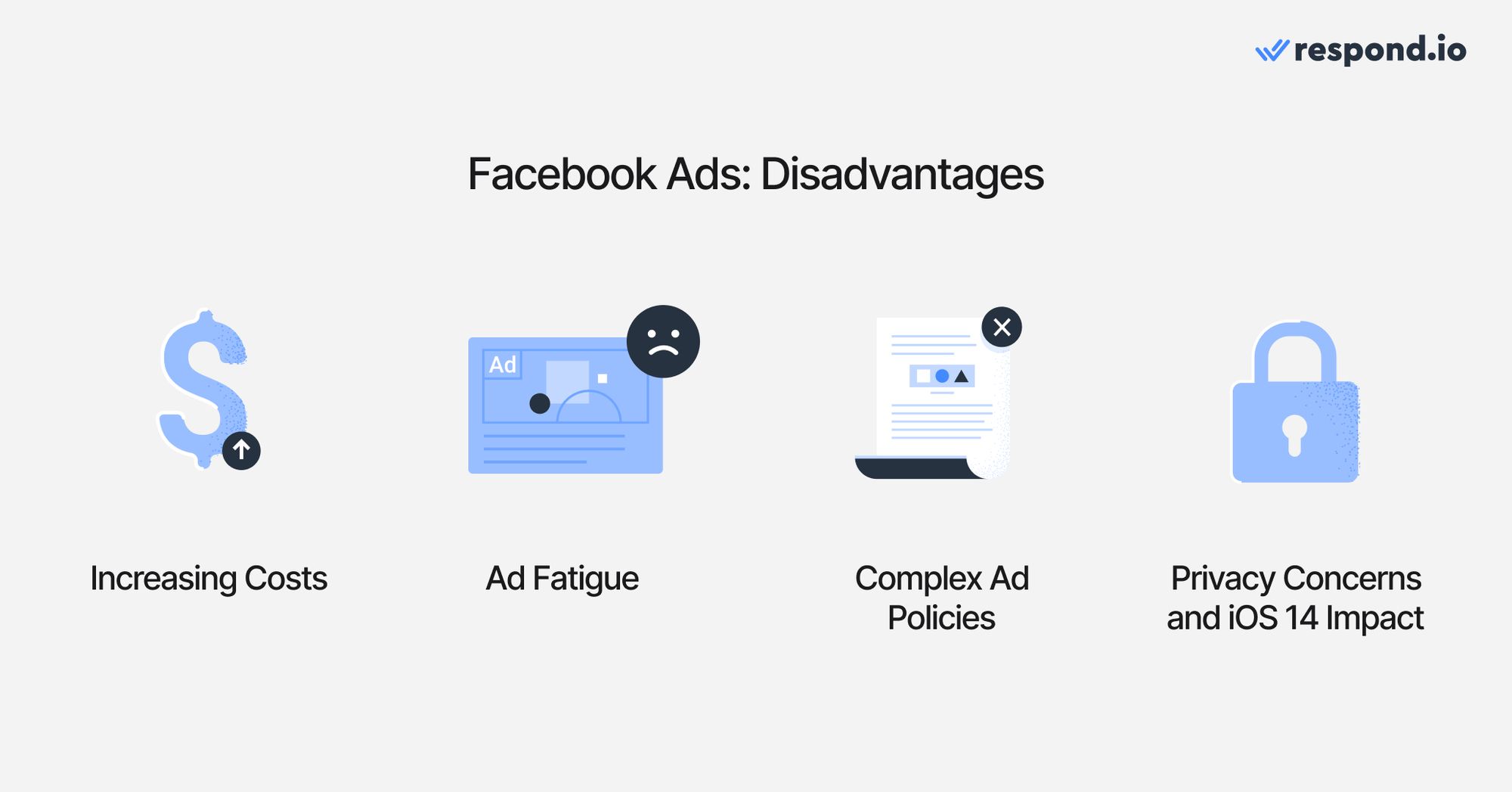
Facebook Ads have long been a staple in digital marketing, but now there's a strong contender on the scene: TikTok Ads. This new option opens a world of possibilities for businesses, yet the question remains—how do TikTok ads stack up against Facebook ads? In this comparison, we’ll delve into the unique features and strengths of each platform to help you decide which might best support your sales and marketing goals. Let’s dive in!
Intro to TikTok Ads vs Facebook Ads
TikTok offers two distinct types of click-to-message ads, each catering to different channels for ongoing conversations after the initial interaction. First, we have TikTok Direct Messaging ads. These allow users to initiate conversations directly within TikTok.
On the other hand, TikTok Instant Messaging ads direct users to popular messaging platforms like WhatsApp or Facebook Messenger—where your customers likely engage daily.

Similarly, Facebook click-to-chat ads facilitate communication by directing leads from Facebook and Instagram straight into Messenger chats, encouraging direct interaction with your brand.
You should know that Meta also provides alternatives to Facebook ads, such as WhatsApp or Instagram Direct ads. These work similarly to Facebook Ads: You can advertise on Facebook or Instagram and capture conversations on WhatsApp and Instagram DM, respectively.
How to Decide Between Facebook Ads vs TikTok Ads
TikTok Ads thrive on short, engaging videos designed to capture attention swiftly, while Facebook Ads leverage a diverse range of formats paired with advanced targeting options to reach specific demographics. So, how do you determine the best platform for your business?
TikTok Ads vs. Facebook Ads: Types of Content
For TikTok, the most popular and cost-effective options include Spark Ads and In-Feed Ads. For businesses seeking greater visibility, premium placements like Top View Ads, Hashtag Challenges, and Branded Lenses are available.

Spark Ads: This format enables businesses to promote existing organic content or user-generated content, preserving authenticity while amplifying the reach of high-performing posts.
In-Feed Ads: These ads blend into TikTok users' feeds, capturing their attention without disrupting the user experience. Highly customizable, In-Feed Ads suit various marketing budgets.
Hashtag Challenges and Branded Lenses: These features encourage users to create and share content around specific themes, leveraging creativity and engagement for potentially viral campaigns.
Top View Ads: Positioned prominently when users open the TikTok app, these ads guarantee high visibility and engagement at a higher cost—ideal for brands aiming for a strong first impression.
In contrast, this is what Facebook ads have to offer.

Facebook and Instagram Stories: These immersive, full-screen ads appear within Stories, ideal for time-sensitive content that grabs attention.
Facebook and Instagram News Feed: Ads here blend organically with user content to drive engagement.
Facebook Marketplace: Targeting active shoppers, these ads appear in a space dedicated to buying and selling, making them very relevant for e-commerce brands.
Facebook Video Feeds: Ads can appear in video content, enhancing storytelling through video ads.
Facebook Right Column: Smaller but visible on desktop, these ads are often used for retargeting campaigns.
Messenger Inbox: Designed for personalized engagement, these ads drive direct conversations through messaging.
TikTok Ads vs Facebook Ads: Targeting
Both platforms offer comprehensive targeting options, including:
Demographic targeting
Interest targeting
Behavior targeting
Device targeting

However, Facebook provides more advanced targeting capabilities and a broader range of audience data. For example, the Meta Pixel allows for precise targeting based on user actions on your website, such as cart additions or purchases.
While TikTok’s algorithm offers intuitive targeting, Facebook's mechanisms provide a more refined approach.
TikTok Ads vs Facebook Ads: Ad Analytics
When it comes to analytics, Facebook’s Ad Manager delivers deep insights into campaign effectiveness, while the TikTok Ad Manager is somehow more basic. However, this is natural, too, as TikTok ads are a much newer feature, and we can expect more improvements in the future.

Overall, Facebook has an edge in performance tracking.
TikTok Ads vs Facebook Ads: Audience Data
Facebook has a wealth of user data, allowing advertisers to gain insights into their target audience’s demographics, interests, behaviors and online activities. This data empowers businesses to create highly personalized and targeted ads.

TikTok ads provide limited audience data, making it challenging for advertisers to gather detailed information about their audience segments. However, TikTok’s user base is known for being young and highly engaged, which can be beneficial for brands targeting that demographic.
TikTok Ads vs. Facebook Ads: Policies
Both Facebook and TikTok have strict advertising policies, and advertisers must familiarize themselves with these policies to ensure compliance and avoid ad disapprovals or account suspensions.
Facebook offers a wide range of ad formats with detailed targeting capabilities but enforces strict guidelines around sensitive topics, political ads and data privacy. Political ads are allowed but require disclosure, while content like misinformation and discriminatory practices are prohibited.

TikTok, however, focuses on protecting its younger audience by banning political ads and placing strong emphasis on community safety.
TikTok ads must adhere to strict rules regarding harmful content, particularly around body image, and are designed to encourage creativity and user engagement. Both platforms require clear labeling for influencer marketing, but TikTok prioritizes authenticity and organic content.
TikTok Ads vs. Facebook Ads: Industries
Facebook serves a broad spectrum of industries, making it a staple for businesses across various sectors.

In contrast, TikTok appeals particularly to brands targeting younger audiences, with industries like fashion, beauty, gaming and lifestyle thriving on the platform.
TikTok Ads vs Facebook Ads: Data Collection
Facebook's data collection is highly detailed and expansive, offering advertisers access to a wide range of user information. Facebook ads collect:
Demographic Data: Information such as age, gender, location and education level.
Behavioral Data: Insights from interaction history, app usage, purchase behavior and online activity.
Interest Data: Data on pages liked, content engagement and preferences based on browsing history.
Third-Party Data: Facebook partners with external data brokers to enhance targeting by incorporating offline behavior, including purchase histories and loyalty memberships.
Engagement Data: Metrics such as likes, shares, comments and overall content engagement.
Device Information: Details about the device type, operating system and browsing behavior.
TikTok | ||
|---|---|---|
Demographic Data | Yes (age, gender, location, education level) | Yes (age, gender, location) |
Behavioral Data | Yes (Interaction history, app usage, purchase behavior, online activity) | Limited (Focus on in-app engagement, not external browsing history) |
Interest Data | Yes (Pages liked, content engagement, browsing history preferences) | Yes (Inferred from engagement patterns with content) |
Third-party Data | Yes (Includes offline behavior, purchase history, loyalty memberships) | Limited (Incorporates some data from advertisers of partners) |
Engagement Data | Yes (Likes, shares, comments or overall content engagement) | Yes (Video likes, shares, comments, watch time) |
Device Information | Yes (Device time, operating system, browsing history) | Yes (Device type, operating system, browsing history) |
Audio & Visual Data | No (Does not focus on audio and visual data) | Yes (Analysis of uploaded videos, sounds and objects) |
In contrast, TikTok focuses its data collection primarily on in-app behavior and content preferences. TikTok ads collect:
Demographic Data: Basic information such as age, gender and location.
Engagement Data: Metrics from video likes, shares, comments and watch time, which TikTok uses to refine its algorithm and recommend content.
Device Information: Information about device type, operating system and browsing history.
Audio and Visual Data: Analysis of uploaded videos, including sounds and detected objects, to better categorize and serve relevant ads.
Interest Data: Inferred from user engagement patterns with content.
Third-Party Data: Limited data incorporation from advertisers or partners.
Attract on TikTok, convert on respond.io ✨
Elevate your TikTok strategy today with TikTok Messaging Ads!
Facebook Ads vs. TikTok Ads: Cost and Performance Comparison
Understanding key metrics such as CPM (Cost per Mille), CPC (Cost per Click), CTR (Click-Through Rate) and CVR (Conversion Rate) is essential for evaluating ad performance. Let’s dive into these metrics to understand which platform is more suitable for you.
Cost Per Mille (CPM)
CPM reflects the cost for every 1,000 impressions.
TikTok: The average CPM is around $10, with lower rates reported as low as $3.21, making it attractive for brands targeting younger audiences.
Facebook: Averaging about $7.19, Facebook offers competitive pricing, varying based on industry and targeting.
Cost Per Click (CPC)
CPC indicates the cost per click on an ad.
TikTok: With an average CPC of $1.00, TikTok’s engaging format makes this competitive, though it can fluctuate with targeting.
Facebook: Matching TikTok at about $1.00, Facebook’s extensive targeting capabilities offer flexibility to optimize CPC for specific sectors.
Click-Through Rate (CTR)
CTR measures ad engagement.
TikTok: Averaging 0.84%, TikTok’s CTR highlights its creative content appeal.
Facebook: With an average CTR of around 0.9%, Facebook’s ecosystem can yield even higher rates depending on the industry.
Conversion Rate (CVR)
CVR shows the percentage of users completing desired actions.
TikTok: With an average CVR of 0.46%, TikTok excels in engagement but may face challenges in driving conversions among younger audiences.
Facebook: Boasting a higher average CVR of 9.21%, Facebook’s robust targeting and retargeting options make it ideal for conversion-focused campaigns.
TikTok | ||
|---|---|---|
Cost per Mile (CPM) | $10, as low as $3.21 | $7.19 |
Cost per Click (CPC) | $1.00 | $1.00 |
Click-through Rate (CTR) | 0.84% | $0.9% |
Conversion Rate (CVR) | 0.46% | 9.21% |
These metrics provide important insights into which platform aligns with your advertising goals. TikTok may be your budget-friendly option, while Facebook could deliver higher-quality clicks—finding the right balance is key.
TikTok Ads vs Facebook Ads: Advantages and Disadvantages
After comparing TikTok ads vs Facebook ads on different levels, let’s talk about their advantages and disadvantages.
TikTok Ads Advantages

Youthful Audience: Perfect for brands targeting Gen Z and Millennials, TikTok is a hotspot for younger users.
Engaging Creativity: The platform’s short video format encourages storytelling and creativity, making ads entertaining and engaging.
Cost-Effective Reach: TikTok generally offers lower CPM and CPC rates, providing a cost-efficient advertising option.
Influencer Marketing: Collaborate with creators to generate authentic content that aligns with your brand.
TikTok Ads Disadvantages

Limited Audience Diversity: Primarily appealing to a younger demographic, TikTok may not suit brands targeting older audiences.
Creativity Requirements: Success hinges on your ability to produce engaging and creative content.
Attribution Challenges: Shorter attribution windows can complicate measuring ad campaign impacts.
Ad Budget Requirements: Certain TikTok features may have steep minimum budget requirements.
Facebook Ads Advantages

Extensive User Base: Facebook’s diverse audience spans multiple generations and demographics.
Advanced Targeting Options: Facebook’s targeting is precise, guiding your ads to the most relevant users.
Proven ROI: Many businesses see impressive returns on investment with Facebook Ads.
Conversion Tracking: Robust tools offer detailed insights into campaign performance, aiding optimization efforts.
Facebook Ads Disadvantages

Increasing Costs: The growing popularity of Facebook Ads may result in rising costs.
Ad Fatigue: Users may become less responsive due to exposure to numerous ads.
Complex Ad Policies: Strict guidelines can lead to ad rejections or account issues if not adhered to.
Privacy Concerns and iOS 14 Impact: Recent privacy regulations have affected targeting and tracking capabilities.
TikTok Ads vs Facebook Ads: Which One Should You Use?
By now, you likely have a clearer idea of which platform might work best for your digital ads. If you're still unsure, don’t miss this section. Here, we’ll summarize the key insights from this blog and provide our recommendation on whether TikTok or Facebook is the best fit for your advertising goals.
Facebook Ads | TikTok Ads | |
|---|---|---|
Ideal for | Targeting a wider demographic (from Gen Z to to Baby Boomers) | Engaging a younger audience (Gen Zers and Millenials) with creative content |
Content Type | Diverse ad formats for various objectives | Short, engaging video ads that align with trending content |
Best for | Conversion-driven campaigns focusing on direct sales and lead generation | Brand awareness campaigns, influencer collaborations, visually-driven |
Advantages | Advanced targeting options, precise audience segmentation, robust conversion | Lower CPM and CPC rates, budget-friendly for larger audiences |
When to Use TikTok Ads
TikTok Ads are the ideal choice when your business aims to engage a younger audience (mainly Gen Z and Millennials) with highly creative and entertaining content.
TikTok's video-driven platform thrives on short, engaging ads that align with trending content, making it perfect for brand awareness campaigns, influencer collaborations, and products that appeal to a visually-driven market.
Additionally, lower CPM and CPC rates make it a budget-friendly option for businesses aiming to reach large audiences cost-effectively, especially in industries like fashion, beauty, and entertainment.
When to Use Facebook Ads
Facebook Ads are best suited for businesses targeting a wider demographic that spans multiple age groups, from Gen Z to Baby Boomers.
With advanced targeting options and precise audience segmentation, Facebook is ideal for conversion-driven campaigns focusing on direct sales, lead generation or customer retention.
Its robust conversion tracking tools make it easier to measure ROI and optimize performance campaigns. If your business requires detailed audience insights or retargeting capabilities, Facebook offers proven ROI and a wealth of analytics to help fine-tune your strategy.
Combining Facebook & TikTok Ads for Success

Gather & Implement Insights Across Platforms
If you want to grow your business in today’s environment, a cross-channel advertising strategy is a must. This means running ads on different channels like search and social, as well as on different platforms within these channels, like TikTok and Facebook within social.
Running ad campaigns across multiple social media platforms enables you to collect more insights and apply more learnings. Be sure to analyze your campaign reports on both TikTok and Facebook frequently to identify these valuable cross-platform opportunities.
Strengthen Your Brand Identity
Maintain a clear tone of voice across these platforms, use the same branding elements (colors, fonts, imagery, vibes), and regularly interact with your audience on both networks. Consistency is a great way to build trust among consumers, so use both Facebook and TikTok as a launchpad for your brand.
Expand your Campaign Reach
Both TikTok and Facebook give you access to unique audiences and specific demographics, so take full advantage of this. Experiment with different target audiences to discover new prospects and ensure both platforms have sufficient budgets for scaling up.
Combine the Power of TikTok and Respond.io to Accelerate Business Results
Respond.io is among the first few badged TikTok Marketing Technology Partners globally. The badge is awarded for expertise in end-to-end TikTok sales and marketing solutions, including sales workflow automation and tools to optimize TikTok ad performance.
What does this mean for your business? As a badged partner, respond.io gives you access to the latest innovations in TikTok Business Messaging. From capturing leads to closing sales, you’ll have the tools to attract, convert and grow customers — all from a single platform.
🚀 Big News! TikTok Instant Messaging Ads are now globally available! Now, businesses can connect with TikTok leads on WhatsApp and Messenger to offer consultations, schedule appointments, and close sales—all in a single conversation. Book a consultation today!
Attract on TikTok, convert on respond.io ✨
Elevate your TikTok strategy today with TikTok Messaging Ads!
FAQ and Troubleshooting
Are Facebook ads cheaper than TikTok ads?
This depends on multiple variables. However, this is generally not the case. On average, TikTok ads have cheaper cost per click (CTC) and cost per mile (CPM) than Meta ads.
Are Facebook or TikTok ads better?
Using both Facebook ads and TikTok ads together can help brands reach more people and achieve their marketing goals. TikTok is great for making fun videos to get people interested in a brand, while Facebook is good for targeting specific groups and getting people to take action.
What are the disadvantages of Facebook ads?
Increasing costs, ad fatigue, complex ad policies, privacy concerns and iOS 14 impact.
What are the disadvantages of TikTok ads?
Limited audience diversity, creativity requirements, attribution challenges and ad budget requirements.
Further Reading
If you enjoyed reading this article, check out these other blogs:






































 Electronics
Electronics Fashion & Apparel
Fashion & Apparel Furniture
Furniture Jewelry and Watches
Jewelry and Watches
 Afterschool Activities
Afterschool Activities Sport & Fitness
Sport & Fitness
 Beauty Center
Beauty Center Dental Clinic
Dental Clinic Medical Clinic
Medical Clinic
 Home Cleaning & Maid Services
Home Cleaning & Maid Services Photography & Videography
Photography & Videography
 Car Dealership
Car Dealership
 Travel Agency & Tour Operator
Travel Agency & Tour Operator




